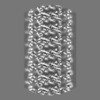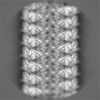[English] 日本語
 Yorodumi
Yorodumi- EMDB-20588: CryoEM reconstruction of membrane-bound ESCRT-III filament compos... -
+ Open data
Open data
- Basic information
Basic information
| Entry | Database: EMDB / ID: EMD-20588 | ||||||||||||||||||
|---|---|---|---|---|---|---|---|---|---|---|---|---|---|---|---|---|---|---|---|
| Title | CryoEM reconstruction of membrane-bound ESCRT-III filament composed of CHMP1B+IST1 (right-handed) | ||||||||||||||||||
 Map data Map data | RELION postprocessed map with helical symmetry applied to the entire map | ||||||||||||||||||
 Sample Sample |
| ||||||||||||||||||
 Keywords Keywords | membrane remodeling / membrane-bound protein filament / ESCRT-III / LIPID BINDING PROTEIN | ||||||||||||||||||
| Function / homology |  Function and homology information Function and homology informationMIT domain binding / multivesicular body-lysosome fusion / amphisome membrane / vesicle fusion with vacuole / ESCRT III complex disassembly / late endosome to lysosome transport / ESCRT III complex / kinetochore microtubule / endosome transport via multivesicular body sorting pathway / cytoskeleton-dependent cytokinesis ...MIT domain binding / multivesicular body-lysosome fusion / amphisome membrane / vesicle fusion with vacuole / ESCRT III complex disassembly / late endosome to lysosome transport / ESCRT III complex / kinetochore microtubule / endosome transport via multivesicular body sorting pathway / cytoskeleton-dependent cytokinesis / collateral sprouting / membrane coat / nuclear membrane reassembly / Sealing of the nuclear envelope (NE) by ESCRT-III / multivesicular body sorting pathway / positive regulation of collateral sprouting / regulation of centrosome duplication / midbody abscission / membrane fission / plasma membrane repair / late endosome to vacuole transport / ubiquitin-dependent protein catabolic process via the multivesicular body sorting pathway / multivesicular body assembly / multivesicular body membrane / Flemming body / regulation of mitotic spindle assembly / mitotic metaphase chromosome alignment / nucleus organization / viral budding via host ESCRT complex / endoplasmic reticulum-Golgi intermediate compartment / autophagosome membrane / positive regulation of proteolysis / autophagosome maturation / nuclear pore / multivesicular body / viral budding from plasma membrane / establishment of protein localization / kinetochore / autophagy / azurophil granule lumen / intracellular protein localization / nuclear envelope / protein transport / midbody / endosome membrane / cadherin binding / protein domain specific binding / lysosomal membrane / cell division / intracellular membrane-bounded organelle / Neutrophil degranulation / centrosome / chromatin / protein-containing complex binding / extracellular exosome / extracellular region / nucleoplasm / identical protein binding / plasma membrane / cytosol Similarity search - Function | ||||||||||||||||||
| Biological species |  Homo sapiens (human) Homo sapiens (human) | ||||||||||||||||||
| Method | helical reconstruction / cryo EM / Resolution: 3.2 Å | ||||||||||||||||||
 Authors Authors | Nguyen HC / Frost A | ||||||||||||||||||
| Funding support |  United States, 5 items United States, 5 items
| ||||||||||||||||||
 Citation Citation |  Journal: Nat Struct Mol Biol / Year: 2020 Journal: Nat Struct Mol Biol / Year: 2020Title: Membrane constriction and thinning by sequential ESCRT-III polymerization. Authors: Henry C Nguyen / Nathaniel Talledge / John McCullough / Abhimanyu Sharma / Frank R Moss / Janet H Iwasa / Michael D Vershinin / Wesley I Sundquist / Adam Frost /  Abstract: The endosomal sorting complexes required for transport (ESCRTs) mediate diverse membrane remodeling events. These typically require ESCRT-III proteins to stabilize negatively curved membranes; ...The endosomal sorting complexes required for transport (ESCRTs) mediate diverse membrane remodeling events. These typically require ESCRT-III proteins to stabilize negatively curved membranes; however, recent work has indicated that certain ESCRT-IIIs also participate in positive-curvature membrane-shaping reactions. ESCRT-IIIs polymerize into membrane-binding filaments, but the structural basis for negative versus positive membrane remodeling by these proteins remains poorly understood. To learn how certain ESCRT-IIIs shape positively curved membranes, we determined structures of human membrane-bound CHMP1B-only, membrane-bound CHMP1B + IST1, and IST1-only filaments by cryo-EM. Our structures show how CHMP1B first polymerizes into a single-stranded helical filament, shaping membranes into moderate-curvature tubules. Subsequently, IST1 assembles a second strand on CHMP1B, further constricting the membrane tube and reducing its diameter nearly to the fission point. Each step of constriction thins the underlying bilayer, lowering the barrier to membrane fission. Our structures reveal how a two-component, sequential polymerization mechanism drives membrane tubulation, constriction and bilayer thinning. | ||||||||||||||||||
| History |
|
- Structure visualization
Structure visualization
| Movie |
 Movie viewer Movie viewer |
|---|---|
| Structure viewer | EM map:  SurfView SurfView Molmil Molmil Jmol/JSmol Jmol/JSmol |
| Supplemental images |
- Downloads & links
Downloads & links
-EMDB archive
| Map data |  emd_20588.map.gz emd_20588.map.gz | 43 MB |  EMDB map data format EMDB map data format | |
|---|---|---|---|---|
| Header (meta data) |  emd-20588-v30.xml emd-20588-v30.xml emd-20588.xml emd-20588.xml | 26.4 KB 26.4 KB | Display Display |  EMDB header EMDB header |
| FSC (resolution estimation) |  emd_20588_fsc.xml emd_20588_fsc.xml | 12.5 KB | Display |  FSC data file FSC data file |
| Images |  emd_20588.png emd_20588.png | 284.1 KB | ||
| Masks |  emd_20588_msk_1.map emd_20588_msk_1.map | 166.4 MB |  Mask map Mask map | |
| Filedesc metadata |  emd-20588.cif.gz emd-20588.cif.gz | 6.2 KB | ||
| Others |  emd_20588_additional_1.map.gz emd_20588_additional_1.map.gz emd_20588_additional_2.map.gz emd_20588_additional_2.map.gz emd_20588_additional_3.map.gz emd_20588_additional_3.map.gz emd_20588_additional_4.map.gz emd_20588_additional_4.map.gz emd_20588_half_map_1.map.gz emd_20588_half_map_1.map.gz emd_20588_half_map_2.map.gz emd_20588_half_map_2.map.gz | 131.6 MB 130.3 MB 131.6 MB 131.6 MB 131.1 MB 131.1 MB | ||
| Archive directory |  http://ftp.pdbj.org/pub/emdb/structures/EMD-20588 http://ftp.pdbj.org/pub/emdb/structures/EMD-20588 ftp://ftp.pdbj.org/pub/emdb/structures/EMD-20588 ftp://ftp.pdbj.org/pub/emdb/structures/EMD-20588 | HTTPS FTP |
-Validation report
| Summary document |  emd_20588_validation.pdf.gz emd_20588_validation.pdf.gz | 1.1 MB | Display |  EMDB validaton report EMDB validaton report |
|---|---|---|---|---|
| Full document |  emd_20588_full_validation.pdf.gz emd_20588_full_validation.pdf.gz | 1.1 MB | Display | |
| Data in XML |  emd_20588_validation.xml.gz emd_20588_validation.xml.gz | 20.1 KB | Display | |
| Data in CIF |  emd_20588_validation.cif.gz emd_20588_validation.cif.gz | 26.2 KB | Display | |
| Arichive directory |  https://ftp.pdbj.org/pub/emdb/validation_reports/EMD-20588 https://ftp.pdbj.org/pub/emdb/validation_reports/EMD-20588 ftp://ftp.pdbj.org/pub/emdb/validation_reports/EMD-20588 ftp://ftp.pdbj.org/pub/emdb/validation_reports/EMD-20588 | HTTPS FTP |
-Related structure data
| Related structure data | 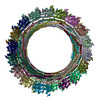 6tz4MC  6tz5C  6tz9C  6tzaC C: citing same article ( M: atomic model generated by this map |
|---|---|
| Similar structure data | |
| EM raw data |  EMPIAR-10396 (Title: CryoEM reconstruction of membrane-bound ESCRT-III filament composed of CHMP1B+IST1 (right-handed) EMPIAR-10396 (Title: CryoEM reconstruction of membrane-bound ESCRT-III filament composed of CHMP1B+IST1 (right-handed)Data size: 30.6 Data #1: Processed particle stack for a cryoEM helical reconstruction of membrane-bound ESCRT-III filament composed of CHMP1B+IST1 (right-handed) [picked particles - multiframe - processed]) |
- Links
Links
| EMDB pages |  EMDB (EBI/PDBe) / EMDB (EBI/PDBe) /  EMDataResource EMDataResource |
|---|
- Map
Map
| File |  Download / File: emd_20588.map.gz / Format: CCP4 / Size: 166.4 MB / Type: IMAGE STORED AS FLOATING POINT NUMBER (4 BYTES) Download / File: emd_20588.map.gz / Format: CCP4 / Size: 166.4 MB / Type: IMAGE STORED AS FLOATING POINT NUMBER (4 BYTES) | ||||||||||||||||||||||||||||||||||||||||||||||||||||||||||||
|---|---|---|---|---|---|---|---|---|---|---|---|---|---|---|---|---|---|---|---|---|---|---|---|---|---|---|---|---|---|---|---|---|---|---|---|---|---|---|---|---|---|---|---|---|---|---|---|---|---|---|---|---|---|---|---|---|---|---|---|---|---|
| Annotation | RELION postprocessed map with helical symmetry applied to the entire map | ||||||||||||||||||||||||||||||||||||||||||||||||||||||||||||
| Projections & slices | Image control
Images are generated by Spider. | ||||||||||||||||||||||||||||||||||||||||||||||||||||||||||||
| Voxel size | X=Y=Z: 1.22 Å | ||||||||||||||||||||||||||||||||||||||||||||||||||||||||||||
| Density |
| ||||||||||||||||||||||||||||||||||||||||||||||||||||||||||||
| Symmetry | Space group: 1 | ||||||||||||||||||||||||||||||||||||||||||||||||||||||||||||
| Details | EMDB XML:
CCP4 map header:
| ||||||||||||||||||||||||||||||||||||||||||||||||||||||||||||
-Supplemental data
-Mask #1
| File |  emd_20588_msk_1.map emd_20588_msk_1.map | ||||||||||||
|---|---|---|---|---|---|---|---|---|---|---|---|---|---|
| Projections & Slices |
| ||||||||||||
| Density Histograms |
-Additional map: RELION Refine3D filtered map with no symmetry applied (C1 map)
| File | emd_20588_additional_1.map | ||||||||||||
|---|---|---|---|---|---|---|---|---|---|---|---|---|---|
| Annotation | RELION Refine3D filtered map with no symmetry applied (C1 map) | ||||||||||||
| Projections & Slices |
| ||||||||||||
| Density Histograms |
-Additional map: RELION Refine3D filtered map with helical symmetry imposed...
| File | emd_20588_additional_2.map | ||||||||||||
|---|---|---|---|---|---|---|---|---|---|---|---|---|---|
| Annotation | RELION Refine3D filtered map with helical symmetry imposed on the central 40% | ||||||||||||
| Projections & Slices |
| ||||||||||||
| Density Histograms |
-Additional map: RELION Refine3D unfiltered half map1 with no symmetry...
| File | emd_20588_additional_3.map | ||||||||||||
|---|---|---|---|---|---|---|---|---|---|---|---|---|---|
| Annotation | RELION Refine3D unfiltered half map1 with no symmetry applied (C1 half1 map) | ||||||||||||
| Projections & Slices |
| ||||||||||||
| Density Histograms |
-Additional map: RELION Refine3D unfiltered half map2 with no symmetry...
| File | emd_20588_additional_4.map | ||||||||||||
|---|---|---|---|---|---|---|---|---|---|---|---|---|---|
| Annotation | RELION Refine3D unfiltered half map2 with no symmetry applied (C1 half2 map) | ||||||||||||
| Projections & Slices |
| ||||||||||||
| Density Histograms |
-Half map: RELION Refine3D unfiltered half map1 with helical symmetry...
| File | emd_20588_half_map_1.map | ||||||||||||
|---|---|---|---|---|---|---|---|---|---|---|---|---|---|
| Annotation | RELION Refine3D unfiltered half map1 with helical symmetry imposed on the central 40% | ||||||||||||
| Projections & Slices |
| ||||||||||||
| Density Histograms |
-Half map: RELION Refine3D unfiltered half map2 with helical symmetry...
| File | emd_20588_half_map_2.map | ||||||||||||
|---|---|---|---|---|---|---|---|---|---|---|---|---|---|
| Annotation | RELION Refine3D unfiltered half map2 with helical symmetry imposed on the central 40% | ||||||||||||
| Projections & Slices |
| ||||||||||||
| Density Histograms |
- Sample components
Sample components
-Entire : membrane-bound ESCRT-III copolymer filament composed of CHMP1B an...
| Entire | Name: membrane-bound ESCRT-III copolymer filament composed of CHMP1B and IST1 |
|---|---|
| Components |
|
-Supramolecule #1: membrane-bound ESCRT-III copolymer filament composed of CHMP1B an...
| Supramolecule | Name: membrane-bound ESCRT-III copolymer filament composed of CHMP1B and IST1 type: complex / ID: 1 / Parent: 0 / Macromolecule list: all |
|---|---|
| Source (natural) | Organism:  Homo sapiens (human) Homo sapiens (human) |
-Macromolecule #1: Charged multivesicular body protein 1b
| Macromolecule | Name: Charged multivesicular body protein 1b / type: protein_or_peptide / ID: 1 / Number of copies: 36 / Enantiomer: LEVO |
|---|---|
| Source (natural) | Organism:  Homo sapiens (human) Homo sapiens (human) |
| Molecular weight | Theoretical: 22.140354 KDa |
| Recombinant expression | Organism:  |
| Sequence | String: MSNMEKHLFN LKFAAKELSR SAKKCDKEEK AEKAKIEKAI QKGNMEVARI HAENAIRQKN QAVNFLRMSA RVDAVAARVQ TAVTMGKVT KSMAGVVKSM DATLKTMNLE KISALMDKFE HQFETLDVQT QQMEDTMSST TTLTTPQNQV DMLLQEMADE A GLDLNMEL ...String: MSNMEKHLFN LKFAAKELSR SAKKCDKEEK AEKAKIEKAI QKGNMEVARI HAENAIRQKN QAVNFLRMSA RVDAVAARVQ TAVTMGKVT KSMAGVVKSM DATLKTMNLE KISALMDKFE HQFETLDVQT QQMEDTMSST TTLTTPQNQV DMLLQEMADE A GLDLNMEL PQGQTGSVGT SVASAEQDEL SQRLARLRDQ V UniProtKB: Charged multivesicular body protein 1b |
-Macromolecule #2: IST1 homolog
| Macromolecule | Name: IST1 homolog / type: protein_or_peptide / ID: 2 / Number of copies: 36 / Enantiomer: LEVO |
|---|---|
| Source (natural) | Organism:  Homo sapiens (human) Homo sapiens (human) |
| Molecular weight | Theoretical: 21.574281 KDa |
| Recombinant expression | Organism:  |
| Sequence | String: MLGSGFKAER LRVNLRLVIN RLKLLEKKKT ELAQKARKEI ADYLAAGKDE RARIRVEHII REDYLVEAME ILELYCDLLL ARFGLIQSM KELDSGLAES VSTLIWAAPR LQSEVAELKI VADQLCAKYS KEYGKLCRTN QIGTVNDRLM HKLSVEAPPK I LVERYLIE IAKNYNVPYE PDSVVMAEAP P UniProtKB: IST1 homolog |
-Experimental details
-Structure determination
| Method | cryo EM |
|---|---|
 Processing Processing | helical reconstruction |
| Aggregation state | helical array |
- Sample preparation
Sample preparation
| Buffer | pH: 7.4 |
|---|---|
| Grid | Pretreatment - Type: GLOW DISCHARGE / Pretreatment - Time: 30 sec. / Details: unspecified |
| Vitrification | Cryogen name: ETHANE / Chamber humidity: 100 % / Chamber temperature: 292 K / Instrument: FEI VITROBOT MARK III Details: Grids were blotted with Whatman No. 1 filter paper for 4-8 seconds with a 0 mm offset at 19C and 100 percent humidity before plunging into liquid ethane. |
- Electron microscopy
Electron microscopy
| Microscope | FEI POLARA 300 |
|---|---|
| Image recording | Film or detector model: GATAN K2 SUMMIT (4k x 4k) / Detector mode: SUPER-RESOLUTION / Average electron dose: 44.0 e/Å2 |
| Electron beam | Acceleration voltage: 300 kV / Electron source:  FIELD EMISSION GUN FIELD EMISSION GUN |
| Electron optics | Illumination mode: FLOOD BEAM / Imaging mode: BRIGHT FIELD |
| Experimental equipment | 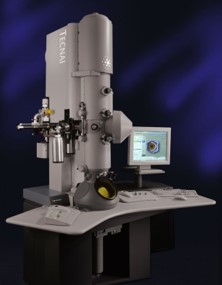 Model: Tecnai Polara / Image courtesy: FEI Company |
 Movie
Movie Controller
Controller



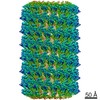





 Z (Sec.)
Z (Sec.) Y (Row.)
Y (Row.) X (Col.)
X (Col.)










